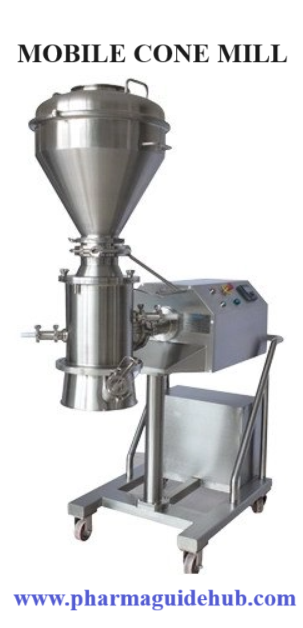
- A mobile cone mill is a versatile piece of equipment that utilizes the power of centrifugal shearing force to grind, shred, and size a variety of dry or wet materials . They are particularly useful for situations where portability is essential.
- CLEANING PROCEDURE FOR MOBILE CONE MILL:
- MINI LAB MODEL, TAPASYA
- Ensure that status label is updated as TO BE CLEANED.
- Ensure that mains to the machine are switched OFF before cleaning.
- Remove labels, materials and containers of previous batch from the area.
- Remove the product discharge chute by unclamp the TC clamp.
- Remove the material if any from the inner surface of the screen by using vacuum cleaner.
- Remove adhered material from the outer surface by using vacuum cleaner and lint free cloth.
- Finally wipe the surface of the cone mill with lint free cloth.
- Update the status label as Cleaned and record the cleaning details in equipment log book
- Frequency: After every batch of the same product.
- TYPE “B” CLEANING:
- Ensure that status label is updated as TO BE CLEANED.
- Ensure that mains to the machine are switched OFF before cleaning and cover all the electrical points with polythene covers.
- Remove labels, materials and containers of previous batch from the area.
- Remove adhered material from the outer surface by using vacuum cleaner and Lint free cloth.
- DISMANTLING OF THE CONEMILL PARTS:
- Remove the product discharge chute by unclamps the tri-clover clamp and keep on SS trolley.
- Remove the screen from the discharge chute and dedust with vacuum cleaner.
- Remove the product hopper by unclamp the Tri-clover clamp, dedust with vacuum cleaner and keep on SS trolley.
- Remove the impeller by loosen the bolt and keep on SS trolley.
- Cover all the dismantled parts with a polybag.
- Transfer all the dismantled parts to the washing area after affixing ‘TO BE CLEANED’ label.
- CLEANING OF MAIN BODY AND AREA:
- Remove any adhering material to the Cone mill body using vacuum cleaner.
- Wipe the body with lint free cloth dipped in potable water until no adherent material is seen, Followed by wiping the Cone mill body with lint free cloth dipped in purified water.
- Remove the polythene cover fixed to the electrical points and wipe them with dry lint free cloth.
- Wipe the walls, ceiling, door, and glass with dry lint free cloth and mop the area with disinfectant solution.
- The status label shall be updated as CLEANED.
- CLEANING OF CONE MILL PARTS:
- Wash the cone mill parts with 30L of potable water until no adherent material is seen.
- Scrub the parts with nylon scrubber until all the adhering material will removes.
- Rinse the parts with 15L of potable water.
- Finally rinse the parts with 20L of purified water.
- Wipe the parts with lint free cloth and allow the parts to dry by using compressed air.
- Transfer the cleaned parts to the cleaned area after affixing CLEANED label.
- Fix back the dismantled parts in the reverse order of dismantling.
- Update the status label as Cleaned and record the cleaning details in equipment logbook.
- Note for Type B Cleaning:
- For Type B Cleaning first clean the equipment with lint free cloth then after clean with potable water. If needed the equipment surface can be rubbed with nylon brush or lint free cloth. If a product is not clean with water, then a cleaning agent can be added in potable water. Then after rinse with potable water and followed the rinsing of equipment with purified water. After rinsing equipment shall be dry with compressed air then wipe with lint free cloth. After drying the surface of equipment shall be wiped with 70% IPA.
- Frequency:
- After every batch of the same product from higher to lower strength and lower to higher strength.
- For Product-to-Product changeovers.
- Major breakdown of equipment.
- As when required.
- REFERENCES:
- Not Applicable
- ANNEXURES:
- Not Applicable
- ENCLOSURES: SOP Training Record.
- DISTRIBUTION:
- Controlled Copy No. 01 : Head Quality Assurance
- Controlled Copy No. 02 : Head Production
- Master Copy : Quality Assurance Department
- ABBREVIATIONS:
| No. | : | Number |
| SOP | : | Standard Operating Procedure |
| IPQA | : | In Process Quality Assurance |
- REVISION HISTORY:
- CHANGE HISTORY LOG
| Revision No. | Details of Changes | Reason for Change | Effective Date |
| 00 | New SOP | Not Applicable | To be written manual |
